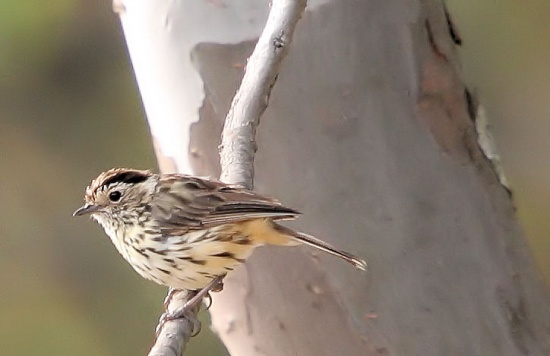- Pyrrholaemus sagittatus
Chthonicola sagittata
Identification
11–12·5 cm (4¼-5 in)
- Large eye
- Pale face
- Greyish-brown upperparts, wings and tail
- Heavily streaked underparts
Male
- Whitish forehead
- Dark brown crown
- Black brow
Female has a rufous eyebrow
Distribution
Central and eastern Queensland through New South Wales to east and central Victoria, Australia.
Taxonomy
This is a monotypic species[1].
Formerly this species was placed in its own genus Chthonicola. Now it's considered to belong to the genus Pyrrholaemus.
Habitat
Open mixed forest, mainly acacias and eucalypts with grassy understorey.
Behaviour
Diet
Their main diet consists of beetles, wasps and other winged insects. They also eat seeds and plants.
Breeding
They build a domed nest with a side entrance from grass and stips of bark. It is placed on the ground protected by low thick foliage. The clutch consists of 3-4 glossy reddish-brown eggs. Both adults feed the young.
References
- Clements, J. F., T. S. Schulenberg, M. J. Iliff, D. Roberson, T. A. Fredericks, B. L. Sullivan, and C. L. Wood. 2015. The eBird/Clements checklist of birds of the world: v2015, with updates to August 2015. Downloaded from http://www.birds.cornell.edu/clementschecklist/download/
- Handbook of the Birds of the World Alive (retrieved February 2016)
- Thewebsiteofeverything
- BF Member observations
Recommended Citation
- BirdForum Opus contributors. (2025) Speckled Warbler. In: BirdForum, the forum for wild birds and birding. Retrieved 17 May 2025 from https://www.birdforum.net/opus/Speckled_Warbler





